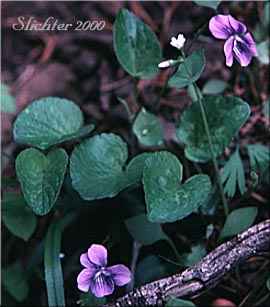 Photo
at right of marsh violets from near the summit of Dog Mt., Columbia River
Gorge........mid May, 1989.
Photo
at right of marsh violets from near the summit of Dog Mt., Columbia River
Gorge........mid May, 1989.Marsh violets are perennials with slender rhizomes, creeping stolons, and flower stalks which are leafless. The flower stalks may be up to 15 cm high. The leaves are all basal, heart or kidney-shaped (See photos.), and 2.5-3.5 cm wide. The leaves are edged with rounded teeth.
The flowers are 10-13 mm long and either white or lavender or violet. The lower 3 petals are typically penciled with purple or even greenish lines.
Marsh violet may be found in moist meadows, sphagnum habitats, and along streambanks. It may be found on wet to very wet soils, and may be found in wet temperate, cool temperate, or boreal climates. It is not tolerant of shade.
Marsh violet may be found from British Columbia south to California, east in Canada to Labrador, and in the United States, east to the Rocky Mts.
In the Columbia River Gorge, it may be found between the elevations of 300'-4000' from east of Multnomah Falls east to about the White Salmon River.